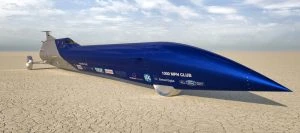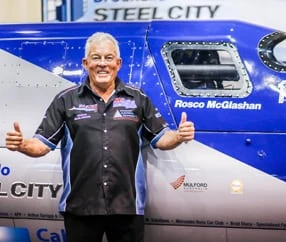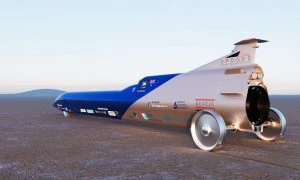Manufacturer News
Aussie’s Rosco aiming for 1000 mph

Aussie Invader 5R
It might be a bit hard to call it a conventional car but then it’s not really a conventional car in the sense that the Aussie Invader 5R rocket-car looks more plane/rocket in its appearance. The Aussie Invader 5R rocket-car boasts an insanely long arrow-shaped design with three wheels, large aerodynamic wind deflectors and an engine with close to 150,000 kW! Yes, that’s correct; you did read that figure correctly. To put that in perspective, an Aussie V8 Supercar puts out, on average, around 475 kW of power. Now, if you’ve ever experienced the wonderful roar of these V8s when they blast by around the circuit, then you can understand the aura of such kW potency. But this Aussie Invader 5R rocket-car makes as much power as 316 of these Aussie V8 Supercars put together! The Aussie Invader 5R rocket-car is powered by a single bi-propellant rocket reportedly capable of producing upwards of 62,000 lbf of thrust. That’s over four times more than a Boeing 737 jet!
Founder and designer of the new Aussie Invader 5R rocket-car, Rosco McGlashan, has the world’s fastest land speed record in his sights. He will reportedly be the pilot of the 16-metre long, nine-tonne steel-framed vehicle. And the target? The target top speed of 1609 km/h (1000 mph) would be the fastest of any land-going vehicle, ever. And 1000 mph would see it blitz the current land speed record held by the Noble Thrust SSC on a Nevada salt flat in 1997, which averaged 1223.7 km/h and broke the sound barrier while doing so.

Rosco McGlashan
Rosco McGlashan would like to set the new record next year once all the Covid palaver is over-and-done-with, and it will likely be set somewhere in the Queensland or Western Australian desert. Rosco is no stranger to setting speed records; he is already the holder of the Australian land speed record, where in 1994 he clocked 802.6 km/h behind the wheel of a jet-powered predecessor to the Aussie Invader 5R out on the dry salt flats of Lake Gairdner, near Adelaide. He has, after all, built all of his drag racing, exhibition, and land-speed racing vehicles himself over the years in a shed at his home.
Rosco has accurate computer modelling on the Aussie Invader 5R rocket-car, which suggests that the Aussie Invader 5R rocket-car will have enough power and thrust for launching the car from 0-100 km/h in approximately 1.1 seconds. It should reach its target of 1000 mph in less than 30 seconds. Slowing the Aussie Invader 5R rocket-car down is no mean feat and will thus will require a full 13 km of flat desert just to stop it. A multi-stage deployment of high-speed hydraulic air brakes, mid-speed parachutes, and low-speed disc brakes have been designed to activate progressively to safely bring the vehicle to a halt.
Picking an exact location will depend largely on which organization or individual steps up as the primary sponsor for the effort. As will the practical necessity of having 5 km of flat desert for getting up to speed plus another 13 km to stop it.

Aussie Invader 5R
Hyundai Caught Up in Global Battery Pack Recall
Hyundai Australia is at the centre of a recall affecting roughly 1100 local electric vehicles sold since 2018 including the popular Hyundai Kona and Hyundai Ioniq, with the vehicles considered at risk of catching fire while recharging. In total, however, the global recall encompasses an estimated 82,000 electric vehicles, which will each require a new battery pack replacement at a grand cost of around $1.1 billion.
It marks one of the first major recalls by any brand as far as battery pack recalls or replacements. While recalls are somewhat par for the course in the automotive industry, EVs have largely escaped a similar fate thus far, with this new development potentially proving a watch-point for a segment of the industry that is looking to generate increased interest among new car buyers.
The recall comes in response to a number of reports overseas where electric vehicles have caught fire. At this stage, there are an estimated 30 cases that have been documented, with some customers advised to limit the charging of their existing batteries to 90% so as to not introduce any risk until such time that the batteries have been replaced.
Commenting on the matter, Lee Hang-koo, senior researcher at the Korea Institute for Industrial Economics & Trade, believes “It’s very significant for both Hyundai and LG as we are in the early stages of the electric vehicle era…How Hyundai handles this will set a precedent not just in South Korea but also for other countries.”

In news that further complicates things, some of the vehicles involved in this latest recall were already singled out last year for being burdened by a separate recall related to electrical problems.
It has also sparked a bit of a war of words between manufacturer and supplier, with Hyundai and LG at odds as to the reasons behind the potential fault.
In the case of Hyundai, South Korean government authorities did the wagering on their behalf, claiming various defects were found in some battery cells produced by battery supplier LG out of its Chinese factory. On the other hand, LG accused Hyundai of misapplying its suggestions regarding the functional operation of fast-charging for its battery management system, dismissing the notion that its battery cells were a direct cause of the fire risks.
Regardless where the issue lies, with this being one of the first major recalls affecting the central technology underpinning the shift to electric vehicles, not only will Hyundai and LG be keen for a quick resolution to the matter, but a number of other parties will be watching closely hoping to avoid any similar shortfall in terms of quality control.
Nissan X-Trail Updates For 2021.
Nissan has provided the X-Trail SUV with a solid list of updates for 2021, bring the mid-sized and popular machine into line with its competition. Across all trim levels, Nissan adds in Android Auto and Apple CarPlay. For the ST-L and above, Intelligent Driver Alert (IDA) is added, whilst for the ST and TS models, DAB audio, finally, has been added. One hopes the screen interface has been updated too and it seems so as they say the next-gen infotainment system for 7.0 inch touchscreens will be standard. The ST-L trim level also has new 18 inch wheels. The ST and TS level also will have voice recognition added in.
Across all trim levels, Nissan adds in Android Auto and Apple CarPlay. For the ST-L and above, Intelligent Driver Alert (IDA) is added, whilst for the ST and TS models, DAB audio, finally, has been added. One hopes the screen interface has been updated too and it seems so as they say the next-gen infotainment system for 7.0 inch touchscreens will be standard. The ST-L trim level also has new 18 inch wheels. The ST and TS level also will have voice recognition added in. The X-Trail also sees an increased safety presence and it’s extensive. Model dependent, buyers will see items such as the aforementioned IDA, plus Forward Collision Warning, Intelligent Cruise Control, Intelligent Emergency Braking and Intelligent Emergency Braking with Pedestrian Detection. The front (model dependent) will have an Adaptive Front Lighting System, Blind Spot Warning, and Moving Object Detection. Rear Cross Traffic Alert, Lane Departure Intervention, and Around View Monitor, will also be seen.
The X-Trail also sees an increased safety presence and it’s extensive. Model dependent, buyers will see items such as the aforementioned IDA, plus Forward Collision Warning, Intelligent Cruise Control, Intelligent Emergency Braking and Intelligent Emergency Braking with Pedestrian Detection. The front (model dependent) will have an Adaptive Front Lighting System, Blind Spot Warning, and Moving Object Detection. Rear Cross Traffic Alert, Lane Departure Intervention, and Around View Monitor, will also be seen.
ST and TS will share 17 inch alloys, idle stop/start for the diesel engines, rear view camera, and Intelligent Emergency Braking with Forward Collision Warning plus Vehicle Dynamic Control. The diesel will be a five seater only, a curious choice given the better, low revving, torque characteristics of diesels which make them far better for carrying passengers.
ST-L has a leather accented tiller and seats, with the front seats having eight and four way power adjustment for the driver and passenger. Ti takes the luxury touches even further with heated door mirrors, LED headlights with self-leveling and swiveling, rain sensing wipers, plus a motion sensing tailgate. Rear seats have heating elements as does the steering wheel, whilst a glass roof can open to share the sounds from an eight speaker Bose audio system. 19 inch alloys underpin the Ti.
Motorvation comes courtesy of a 2.0L petrol engine with 106kW and 200Nm, and 2.5L with 126kW and 226Nm. A 2.0L diesel offers 130kW and 380Nm and that’s available from 2,000rpm. Economy for that is quoted as 6.0L/100km (combined). The smaller petrol engine is quoted as 8.2L/100km (ST manual) with the 2.5L at 7.9L/100km and available in the ST, ST-L, and Ti. Tanks are 60.0L for all models.
The 2WD-only 2.0-litre powered X-TRAIL ST uses a smooth-shifting six- speed manual transmission, whereas all 2.5-litre variants (available in both 2WD and 4WD) are mated to Nissan’s Xtronic CVT with manual mode (MCVT). This transmission’s broad gear ratio coverage and low-friction design help deliver strong acceleration and fuel economy. The AWD systems have a console centre dial with 2WD, Auto (torque split on demand) and Lock.
Pricing starts from $30,665 (plus ORC) for the ST manual, $32,665 (plus ORC) for the CVT five seater and $34,265 (plus ORC) for the seven seater. These are two wheel drive only. The ST CVT AWD is an extra $400. TS AWD diesel auto starts from $37,465 plus ORC.
ST-L is two wheel drive five and seven seater, and AWD, with $38,525, $40,125, and $40,525 plus ORC. Ti is AWD only and starts from $45,965 plus ORC and includes tan leather and no extra cost.
A Class-C Update From Mercedes.
Mercedes-Benz have updated their evergreen C-Class saloon and Estate with what Gordon Wagener, the chief design officer of the Daimler group said reflected the desire to apply “sensual purity”. It’s due for release in the northern hemisphere’s summer season.
The new C-Class will feature both forms of hybrid tech, being petrol and PHEV, and will run 48V technology. The battery alone will power the C-Class for up to 100 kilometres, the company says. The petrol engines will be four cylinders from what M-B call FAME (Family of Modular Engines). Along with turbocharging both the petrol and diesel engines the C-Class will have, M-B add in an ISG or integrated starter-generator. This provides low speed assistance using a 48 volt on-board electrical system that ensures functions such as gliding, boosting or energy recovery. Fast re-engagement has seamless switching from off to on when at lights or a stop sign.
Two engines with petrol will be available, one of 1.5L, the other of 2.0L. 125kW/250Nm for the C180, 150kW/300Nm for the C200 and C200 4MATIC from the 1.5L, with 190kW/400Nm for the C300 and C300 3MATIC versions. A pair of 2.0L diesels factor in, with 147kW/440Nm and 195kW/550Nm. Top speeds are limited at the upper end of the range to 250kph.
The plug-in hybrid C-Class will operate in all-electric mode in many cases thanks to an electric output of 95 kW (129 hp) and an all-electric range of around 100 kilometres. For many areas in Europe this could mean little to no ICE (Internal Combustion Engine) usage. The battery is an in-house design and built in a “pouch configuration” with 96 cells, with a total capacity of 25.4kWh. There is an internal cooling system fitted, managing heat discharge in any driving environment. The high density structure allows a charge rate of 30 minutes to full from empty using a 55kW charger. An 11kW charger is standard.
Energy recovery rates can be driver controlled via rocker switches in the console across all driving modes except for Sport. Lifting the foot from the accelerator has the regenerative system act like brakes, slowing the C-Class whilst simultaneously feeding back energy to the battery. Mercedes-Benz have engineered in two additional driving modes which will enable the driver to take advantage of what the powertrain offers: BATTERY HOLD: Maintaining the charge state of the high-voltage battery is given priority, e.g. when intending to drive in a city centre or green zone later on; selection of the most suitable drive configuration by the hybrid powertrain system, depending on the driving situation and route, and ELECTRIC: Electric driving up to 140 km/h, adjustable energy recovery rate in overrun mode, adaptation of Active Distance Assist DISTRONIC for electric driving, activation of the combustion engine using a pressure point of the accelerator pedal (kick-down).
Extra tech sees optional rear-axle steering with 2.5 degrees of angle reducing a turning circle to 10.5 metres. These have the rear wheels in an opposite direction in steering at speeds up to 60kph, then align with the direct front steering above 60kph. The rear steering also effectively reduces the steering ratio to 2.1 turns lock to lock, down from 2.35.
Notable changes to both the saloon and wagon have seen increase to the overall dimensions. The previous model saloon jumps from 4,686mm to 4,751mm in length, the Estate from 4,702mm to 4,751mm. Width is up by 10mm and 20mm respectively to 1,820mm each. Both share an increased wheelbase of 2,865mm, up from 2,840mm each. Luggage capacity for the Estate ranges from 490L to 1,510L, with a slightly lower load lip, and the rears eats have a 40/20/40 split for extra versatility. A powered tailgate is standard across the range.
Australian delivery dates are yet to be confirmed.


